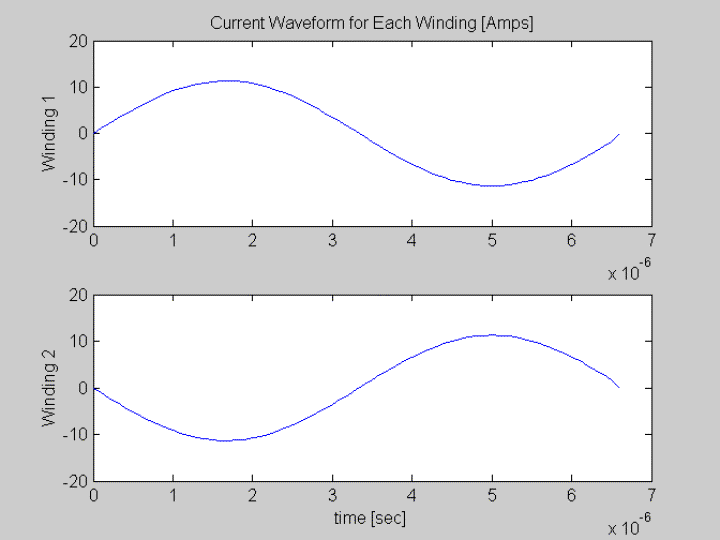
%For an example and help, go to www.thayer.dartmouth.edu/inductor/litzopt or refer to winding data for use with litzopt.%Please replace the question marks with the pertinent data and leave all else alone....
%There are 2 windings in your transformer.
%Resistivity (1.77e-8 is for room temperature
copper)
rhoc =1.77e-8;
%
[ohm-meters]
%Perform optimization on designs with wire sizes
ranging from American Wire Gauge strand size (32 to 48 is the default)
awg =
[32:2:48]; %
%Average turn length for each winding ... 2 elements
are required in this vector.
len =[ 97.3e-3
97.3e-3];
%
%Duration of each time segment ... 100 elements
are required in this vector.
divisions=100;
f=150e3;
%
150 Khz
period=1/f;
inc=period/divisions;
dt =inc*ones(1,divisions);
%Current at the end of the last interval is assumed
equal to the first current value.
%Current values
for winding 1 at the beginning of each time segment ... 101 elements are
required in this
vector.
A=8*sqrt(2);
%
Waveform Amplitude
t=[0:inc:period-inc];
w=2*pi*f;
I(1,:)=A*sin(w.*t);
%Current at the end of the last interval is assumed equal to the first current value.
%Current values for winding 2 at the beginning
of each time segment ... 101 elements are required in this
vector.
I(2,:)= -I(1,:);
%Number of turns in each winding... 2 elements
are required in this vector.
N=[
30
30]; %[turns]
%Breadth of the winding window in meters.
bw=0.0446;
gap='No Gap';

%For an example and help, go to www.thayer.dartmouth.edu/inductor/litzopt, or refer to winding data for use with litzopt.
%Please replace the question marks with the pertinent data and leave all else alone....
%There are 2 windings in your transformer
%Resistivity (1.77e-8 is for room temperature
copper)
rhoc =1.77e-8;
%
[ohm-meters]
%Perform optimization on designs with wire sizes
ranging from American Wire Gauge strand size (32 to 48 is the default)
awg =
[32:2:48]; %
%Average turn length for each winding...
len =[ 3.79e-2
5.08e-2 ];
%[meters]
%Duration
of each time segment ... 3 elements are required in this vector
dt = [3.8e-6
.07e-6 3.9e-6];
%Current values for winding 1 at the beginning
of each time segment ... 3 elements are required in this vector.
I(1,:)=[0
11.4 0 ];
%Current at the end of the last interval is assumed equal to the first current value
%Current values for winding 2 at the beginning
of each time segment
I(2,:)=
[0 0 -11.4/7
]; %[amperes]
%Volume of each winding...
vol=[ 0.0821
0.2480 ].*1e-5;
%[cubic
meters]
%Number of turns in each winding...
N=[ 7
49 ]; %[turns]
%Integral of Bsquared values from simulation with
current in winding 1
% Enter
integral of B squared over winding 1
int_B2(1,1,1)=7.3875e-015;
%[T^2-m^3
]
% Enter integral of B squared over winding 2
int_B2(1,1,2)=2.7289e-015;
%[T^2-m^3
]
%Integral of B squared values from simulation with current in winding 1 and 2
% Enter integral
of B squared over winding 1
int_B2(1,2,1)=
1.3110e-015; %[T^2-m^3
]
% Enter integral of B squared over winding 2
int_B2(1,2,2)=3.3920e-015;
%[T^2-m^3
]
%Integral of Bsquared values from simulation with current in winding 2
% Enter integral
of B squared over winding 1
int_B2(2,2,1)=1.0290e-014;
%[T^2-m^3
]
% Enter
integral of B squared over winding 2
int_B2(2,2,2)=6.4625e-015;
%[T^2-m^3
]
32 0.03059
5.942
0.5236
0.1585
34 0.04906
3.896
1.299
0.3932
36 0.07962
2.591
3.209
0.9715
38 0.1327
1.749
7.933
2.402
40 0.2331
1.201
19.74
5.975
42 0.4485
0.8492
49.06
14.85
44 1
0.6302
117.2
35.47
46 2.824
0.487
260
78.71
48 10.44
0.383
544.5
164.8